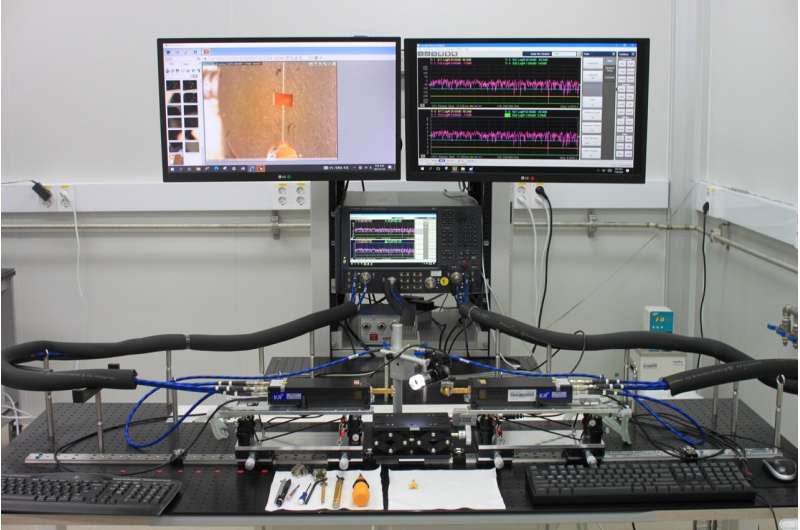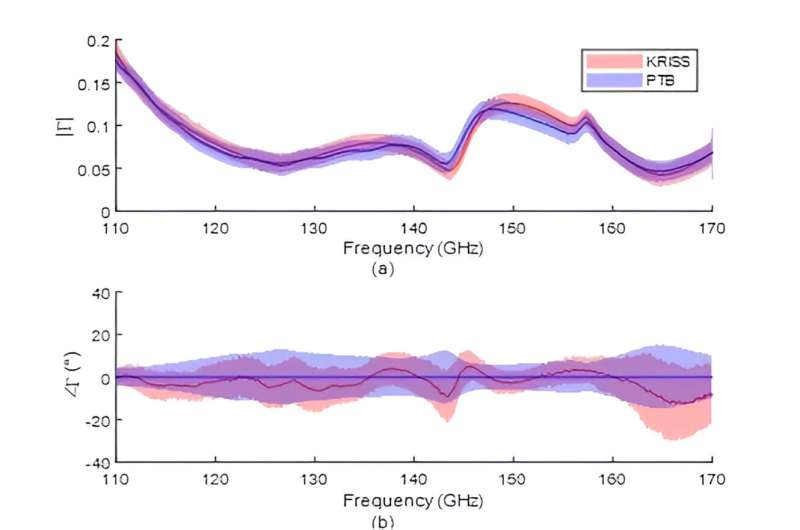Establishing an electromagnetic wave measurement standard for 6G

The Korea Research Institute of Standards and Science (KRISS, President Hyun-min Park) has developed an electromagnetic wave measurement standard for a candidate frequency band of 6G.
The newly developed standard pertains to the electromagnetic impedance of the D-band (110–170 GHz), which shows promise as a 6G candidate frequency band. This is one of the essential standards among electromagnetic wave measurement standards, serving as a criterion for performance evaluation in fields where electromagnetic waves are utilized, such as communication and defense.
The frequency range to be used for 6G has not been decided yet. However, the high-frequency range is considered suitable for the fast transmission of large-capacity data because the higher the frequency range, the broader the communication bandwidth in general. It is akin to how the 16-lane roads can handle more traffic than the two-lane roads.
The D-band frequency, corresponding to the sub-Terahertz range among high-frequency bands, has come under the spotlight as a candidate frequency for 6G. This is because it experiences minimal losses due to water vapor or oxygen and can transmit a large number of signals over a wide bandwidth, both distantly and uniformly.

The Electromagnetic Wave Metrology Group at KRISS has established an electromagnetic wave impedance measurement standard for the D-band, becoming the third in the world after Japan and Germany. Moreover, the international equivalence has been secured through the comparison with Germany. This marks the first international comparison for impedance measurement standards above 110 GHz.
The primary frequency range for 5G communication is below 30 GHz, and the established electromagnetic wave measurement standards have been confined to frequencies below 110 GHz. Even if 6G-related components or parts usable above the D-band are developed, there has been a lack of standards for performance evaluation.
Developing a new standard enables the verification of the performance of various 6G-related components and parts with high reliability. This standard is applicable not only to 6G but also to all fields utilizing electromagnetic waves at D-band frequencies, including defense radar systems.
KRISS has developed its own D-band impedance calibration device to distribute the newly developed electromagnetic wave standard to the industrial sector. Previously, circuit analyzers used for impedance measurements had to be calibrated with expensive imported devices. However, with this domestication, more precise measurement standards can now be provided to the industry at significantly reduced costs.

Dr. Jae-Yong Kwon, a head of the Electromagnetic Wave Metrology Group, said, “The development of the new standard and the domestication of calibration devices will help Korea secure international credibility for domestic 6G technology. We will establish additional electromagnetic wave measurement standards for RF power, attenuation, antennas, and more, and continue follow-up research up to the 300 GHz frequency band, allowing stable adaptation to 6G.”
Such follow-up research has not yet been explored internationally, and the Electromagnetic Wave Metrology Group at KRISS has received collaboration proposals from leading countries such as Germany and the United States. KRISS expects to continue research for securing Korea’s leadership in 6G technology by working closely with its industrial and academic partners, including LG Electronics and KAIST.
The findings are published in the journal IEEE Transactions on Instrumentation and Measurement.
More information:
Chihyun Cho et al, Establishing a D-Band Waveguide Impedance Standard Including the Random Effects of a Vector Network Analyzer for 6G Wireless Communications, IEEE Transactions on Instrumentation and Measurement (2023). DOI: 10.1109/TIM.2023.3291794
Citation:
Establishing an electromagnetic wave measurement standard for 6G (2023, November 10)
retrieved 10 November 2023
from https://techxplore.com/news/2023-11-electromagnetic-standard-6g.html
This document is subject to copyright. Apart from any fair dealing for the purpose of private study or research, no
part may be reproduced without the written permission. The content is provided for information purposes only.
For all the latest Technology News Click Here
For the latest news and updates, follow us on Google News.

